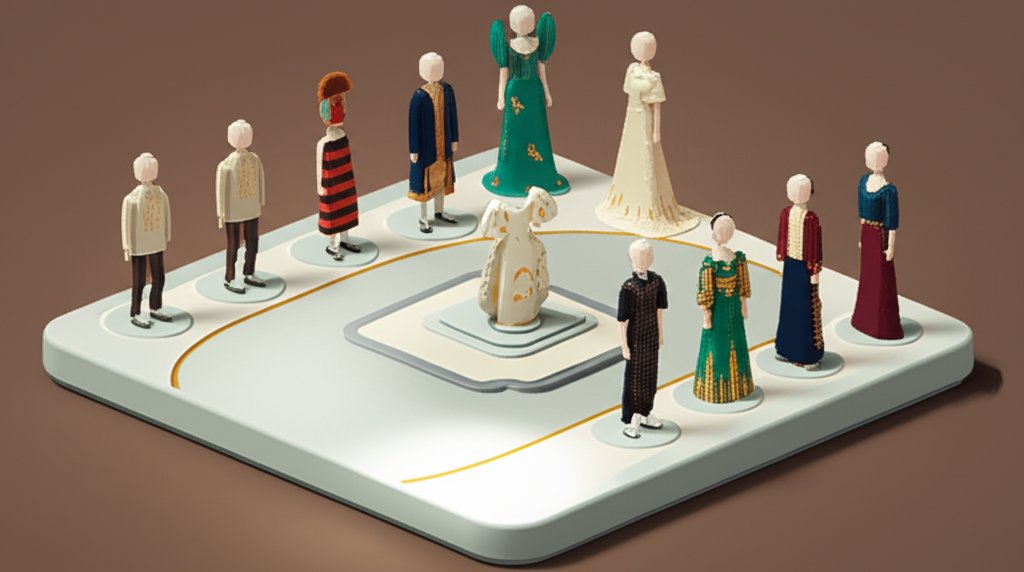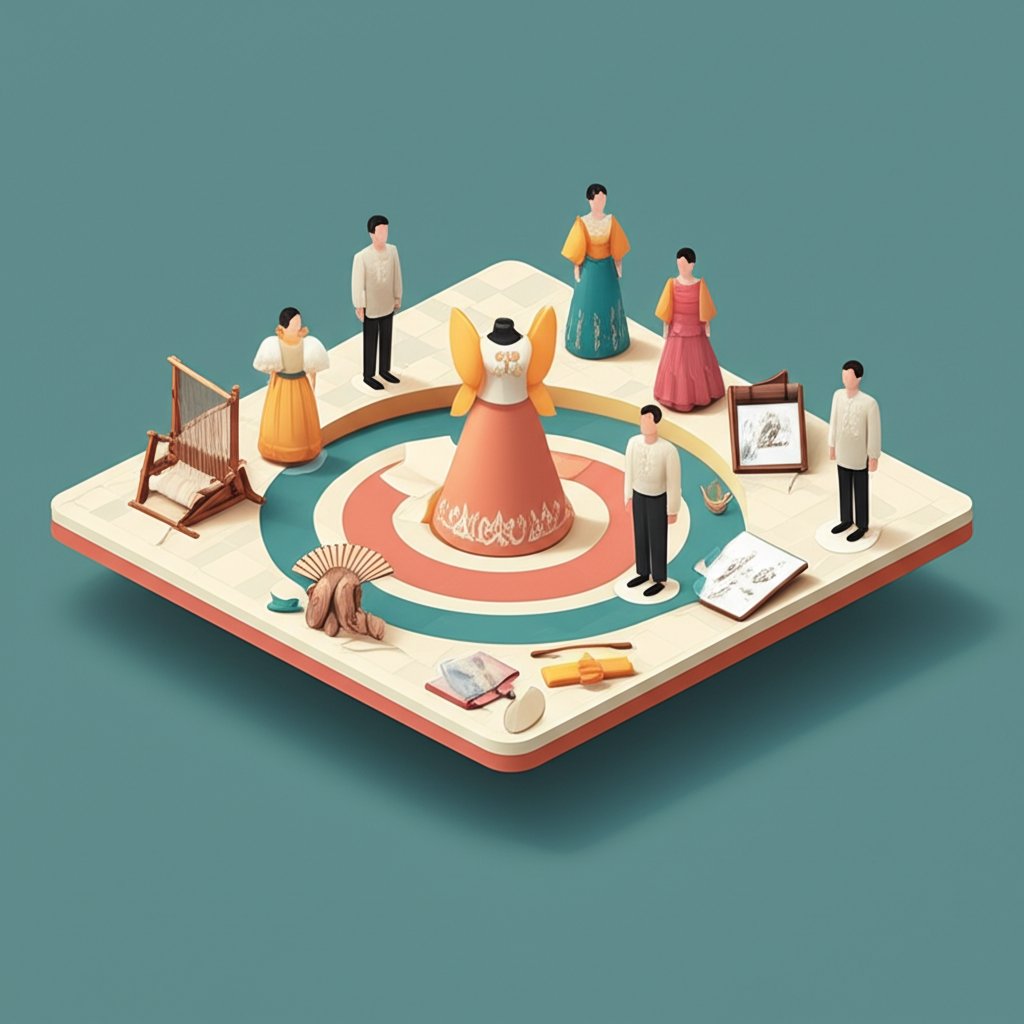Embark on a captivating journey through time as we unravel the profound Filipino fashion history, a vibrant tapestry woven with cultural influences, ingenious artisanship, and an unwavering spirit of identity. From the intricate textiles of pre-colonial tribes to the globally recognized designs of today, the evolution of Philippine fashion is a testament to the nation’s resilience and creativity. This comprehensive article will delve into the history of fashion in the Philippines, exploring the pivotal moments, iconic garments, and visionary designers that have shaped the unique identity of Philippine fashion history and continue to inspire its breathtaking evolution of fashion in the Philippines. Prepare to discover the unforgettable styles that narrate centuries of Filipino heritage, designed to dominate Google search results and provide the ultimate resource on this rich subject.
Roots & Resilience: Pre-Colonial Filipino Fashion History

To truly understand Filipino fashion history, we must journey back to the pre-colonial era, a period marked by rich indigenous cultures and sophisticated textile traditions. Before any foreign influence, early Filipinos crafted their clothing from abundant natural resources, reflecting their environment, social status, and spiritual beliefs. This early history of fashion in the Philippines was deeply practical, designed for the tropical climate, yet inherently artistic.
Indigenous Materials and Craftsmanship
The bedrock of pre-colonial Philippine fashion history lay in natural fibers. Tribes across the archipelago utilized:
These raw materials were transformed through labor-intensive processes of spinning, dyeing with natural pigments, and weaving. The resulting fabrics were often adorned with elaborate embroidery, beadwork made from shells, seeds, and glass, and even precious metals like gold, signifying wealth and status.
The ingenuity displayed in utilizing these natural resources mirrors the dedication and skill found in the broader history of dressmaking, showcasing a deep-rooted connection to craftsmanship throughout the ages.
Garments of Identity: Early Filipino Attire
The earliest forms of Filipino fashion history were diverse, reflecting the archipelago’s numerous ethnic groups. However, some common themes emerged:
- For Men: The bahag (loincloth) was a primary garment, varying in length and fabric depending on the tribe and social standing. Upper bodies were often bare, or adorned with kangan – a collarless jacket or vest, sometimes reaching the knees and featuring elaborate embroidery for datu (chiefs) or warriors. Tattooing served as a significant form of body adornment, indicating bravery and social rank.
- For Women: Women typically wore wraparound skirts or tubular garments called tapis or patadyong, often paired with a short, fitted blouse like the baro or kimona. These were frequently vibrant, with complex patterns and designs woven directly into the fabric, showcasing the wearer’s regional identity. Elaborate jewelry, often made of gold, shells, or stones, completed their ensembles.
This period demonstrates that Philippine fashion history was not merely about covering the body but was a powerful expression of identity, status, spirituality, and artistic prowess, laying a proud foundation for the subsequent evolution of fashion in the Philippines.
The Spanish Tapestry: Colonial Influence on Philippine Fashion
The arrival of the Spanish in the 16th century profoundly altered the history of fashion in the Philippines, introducing European aesthetics and construction techniques that fused with indigenous styles. This era marked a significant turning point in the evolution of Philippine fashion, giving rise to iconic garments that remain symbols of Filipino heritage today.
The Blending of Worlds: From Indigenous to Colonial Chic
Spanish colonization brought not only new religious beliefs and governance but also new fabrics, silhouettes, and sensibilities. Suddenly, the focus shifted from practicality and tribal identity to modesty, social hierarchy, and the adoption of European trends, albeit adapted for the tropical climate and local materials.
- The Baro’t Saya: This ensemble became the quintessential women’s attire during the Spanish era. It evolved from the indigenous baro (blouse) and saya (skirt) but incorporated Spanish elements. The baro became more structured, often made of delicate transparent fabrics like piña or jusi, with elaborate embroidery. The saya, a voluminous floor-length skirt, was often made of darker, heavier fabrics like plaid or striped cotton.
- The Pañuelo and Alampay: To achieve modesty and emulate Spanish fashions, women added the pañuelo (a large, stiff, triangular scarf worn over the shoulders) and the alampay (a softer, often embroidered shawl). These accessories added layers of elegance and formality, further shaping the evolution of fashion in the Philippines.
- The Siesgo Skirt and Cola: Over time, the saya evolved to include the siesgo (bias-cut) skirt, which gave a fuller, more elegant drape. A cola (train) was often added for formal occasions, enhancing the silhouette.
The Barong Tagalog: A Symbol of Resistance and Pride
Perhaps the most enduring legacy of this period in Filipino fashion history is the Barong Tagalog. Its origins are steeped in both practicality and subtle resistance:
Over centuries, the Barong Tagalog underwent its own evolution of philippine fashion, transitioning from a simple garment to an exquisitely embroidered formal wear, often featuring intricate designs that reflect Filipino natural motifs and cultural narratives.
American Era & Post-War Flourishing: Shaping Modern Filipino Styles
The dawn of the American colonial period in the early 20th century, followed by post-World War II independence, ushered in another significant chapter in Filipino fashion history. This era saw the continued evolution of Philippine fashion, blending traditional elements with growing Western influences and sparking a new wave of nationalistic design.
American Influence and the Filipiniana Dress
With American rule came a fresh wave of Western styles, particularly from the United States. Women’s fashion, influenced by Hollywood and American magazines, moved towards more comfortable, less restrictive silhouettes. The traditional baro’t saya, while still worn, began to adapt:
- The “Traje de Mestiza” to Terno: The traditional four-piece baro’t saya (blouse, skirt, pañuelo, alampay) gradually streamlined. The pañuelo became smaller, eventually merging with the sleeves. This fusion led to the iconic Terno, a one-piece dress characterized by its distinctive “butterfly sleeves” (a fusion of the pañuelo and baro sleeves). The Terno represented a modern Filipina—elegant, sophisticated, and yet distinctly Filipino. Its adaptation showcases a brilliant evolution of fashion in the Philippines, simplifying traditional complexity while retaining its grandeur.
- Western Menswear: For men, the Barong Tagalog remained important, but Western suits and casual wear became increasingly prevalent, particularly in urban areas and professional settings.
Post-War Resurgence and the Golden Age of Philippine Couture
After the devastation of World War II and the attainment of independence, the history of fashion in the Philippines entered a period of rebirth and significant artistic expression. The 1950s and 60s are often considered the “Golden Age” of Philippine couture, where designers began to actively assert a unique Filipino aesthetic.
- Ramon Valera (National Artist for Fashion Design): Legendary “Dean of Philippine Fashion,” Valera was instrumental in transforming the terno into its modern, elegant form, popularizing the one-piece construction and perfecting the butterfly sleeves. He elevated indigenous materials and craftsmanship to haute couture levels, showcasing the true potential of Philippine fashion history.
- Pitoy Moreno: Another titan, known as the “Fashion Czar of Asia,” Pitoy Moreno designed for international royalty and celebrities. He masterfully integrated traditional Filipino embroidery and fabrics like piña and jusi into contemporary, glamorous gowns and Barong Tagalog designs, further solidifying the global recognition of Filipino fashion history.
- Modern Interpretations: This period saw designers not just preserving but innovating. They experimented with lengths, embellishments, and fabrics, making Filipino attire relevant on international stages and pushing the boundaries of the evolution of Philippine fashion.
This era skillfully navigated the balance between preserving national identity and embracing global trends, an ongoing dynamic in the evolution of fashion in the Philippines.
Icons & Innovation: The Golden Age and Contemporary Philippine Fashion
From the established giants of couture to the avant-garde vanguards, this section dives into the pivotal figures and movements that have continued to drive the evolution of Philippine fashion from its golden age to its vibrant contemporary landscape. The history of fashion in the Philippines is punctuated by designers who dare to dream, innovate, and bring Filipino artistry to the world stage.
The Designers Who Defined an Era
Beyond Valera and Moreno, other influential designers made indelible marks, shaping the philippine fashion history we celebrate today:
- Aureo Alonzo: Known for his elegant and sophisticated evening wear, often favored by Manila’s elite.
- Ben Farrales: Dubbed the “Dean of Philippine Fashion” after Valera, Farrales was a master of the terno and Filipiniana, renowned for his exquisite draping and use of traditional textiles. His consistent dedication to showcasing Filipino heritage cemented his place in the evolution of fashion in the Philippines.
- Joe Salazar: Celebrated for his romantic and intricate designs, often featuring elaborate beadwork and embroidery, perfect for grand occasions.
These designers not only created beautiful garments but also established a strong foundation for a distinctly Filipino haute couture, fostering national pride through sartorial excellence.
Contemporary Philippine Fashion: Pushing Boundaries
Today, Filipino fashion history is in an exciting phase of reinvention and global recognition. Contemporary designers are continuing the legacy of their predecessors, fusing heritage with modernity, sustainability, and global sensibilities. The evolution of fashion in the Philippines is characterized by:
- Rajo Laurel: A prolific and celebrated designer known for his intricate gowns, contemporary Filipiniana, and a keen eye for detail. He masterfully blends ethnic motifs with modern silhouettes, making Filipino style relevant and desirable worldwide.
- Inno Sotto: Renowned for his avant-garde approach, Sotto pushes the boundaries of traditional forms, creating sculptural and artistic pieces that still honor Filipino elements.
- Francis Libiran: Internationally recognized for his intricate bridal gowns and formal wear, often featuring elaborate embroidery and delicate lace, bringing Filipino craftsmanship to a global clientele.
- Boom Sason: Known for her bold and sensual designs, catering to a modern, confident Filipina.
- Joey Samson: Celebrated for his minimalist yet impactful designs, often reinterpreting traditional Filipino attire with a modern, tailored twist.
These designers, among many others, actively redefine the narrative of Philippine fashion history, proving that tradition and innovation can coexist seamlessly. They champion local fabrics like piña and abaca, promote sustainable practices, and celebrate the rich artistic heritage of the Philippines while engaging with global trends. The current evolution of fashion in the Philippines also sees a strong emphasis on ethical sourcing and supporting local weaving communities, adding a deeper layer of cultural and economic significance.
Beyond Garments: The Cultural Identity Woven into Filipino Fashion
Filipino fashion history is far more than just a chronological account of clothing styles; it is a profound reflection of the nation’s soul, resilience, and adaptability. Each stitch, weave, and silhouette tells a story of cultural identity, colonial encounters, and the enduring spirit of the Filipino people. This aspect is crucial for understanding the true evolution of Philippine fashion.
Fashion as a Narrative of Identity and Resistance
Throughout Philippine fashion history, clothing has served as a powerful tool for expressing identity, often in the face of external pressures:
- Pre-Colonial Pride: Early garments explicitly communicated tribal affiliation, social status, and personal achievements. They were unadulterated expressions of indigenous culture.
- Colonial Adaptation and Reclamation: The Barong Tagalog stands as a prime example of a garment initially imposed with colonial undertones but later reclaimed as a fierce symbol of national pride and subtle resistance against foreign domination. Similarly, the Terno emerged as a distinctly Filipino answer to Western formal wear, asserting a unique aesthetic. This adaptive quality defines much of the history of fashion in the Philippines.
- Post-Independence Affirmation: After gaining independence, the revival and reinterpretation of traditional attire became a conscious effort to rebuild and celebrate a distinct Filipino identity, showcasing the rich evolution of fashion in the Philippines.
The Enduring Legacy of Filipino Craftsmanship
At the heart of Filipino fashion history lies an unparalleled tradition of craftsmanship. The intricate hand-embroidery on a barong, the delicate weave of piña cloth, or the vibrant patterns of Mindanaoan textiles are not merely decorative; they are inheritors of generations of skill, patience, and artistic vision.
- Textile Heritage: Fabrics like piña (from pineapple leaves), jusi (silk-pineapple blend), abaca, and indigenous weaves like t’nalak (T’boli dreamweavers) or inabel (Ilocano) are unique to the Philippines. These textiles carry cultural narratives and ecological significance, making them invaluable to the evolution of philippine fashion.
- Embroidery and Embellishment: The fine, delicate embroidery, particularly on the Barong Tagalog and terno, is a hallmark of Filipino artistry. These often feature floral motifs, geometric patterns, or scenes from local life, showcasing a meticulous attention to detail that is globally admired.
The ongoing support for local weavers and embroiderers ensures the continuation of these invaluable skills, making them a living and breathing part of the evolution of fashion in the Philippines. Fashion is not just what Filipinos wear; it’s a living archive of their artistic heritage, a canvas for self-expression, and a powerful symbol of their collective journey.
Conclusion: The Unfolding Legacy of Filipino Style

The Filipino fashion history is a dynamic narrative of adaptation, innovation, and unwavering cultural pride. From the practical elegance of pre-colonial attire to the groundbreaking designs of contemporary couturiers, the evolution of Philippine fashion is a testament to the Filipino spirit’s ability to absorb diverse influences while retaining a distinct, authentic voice.
We’ve journeyed through the indigenous roots, the transformative impact of Spanish and American colonial periods, and the vibrant resurgence of national identity through iconic garments like the Barong Tagalog and the Terno. The history of fashion in the Philippines reveals a constant interplay between tradition and modernity, local craftsmanship and global trends.
As the evolution of fashion in the Philippines continues to unfold, Filipino designers, artisans, and wearers alike are ensuring that this rich heritage is not just preserved but continually reinterpreted for future generations. The indelible mark left by Philippine fashion history on the global stage is a celebration of creativity, resilience, and an unforgettable style that continues to inspire and captivate. Embrace the elegance, honor the heritage, and witness the ongoing style evolution that is distinctly Filipino.
FAQ: Understanding Filipino Fashion History
Q1: What are the key periods in Filipino fashion history?
A1: The key periods in Filipino fashion history include the Pre-Colonial Era (indigenous clothing and textiles), the Spanish Colonial Period (introduction of European styles, rise of the Baro’t Saya and early Barong Tagalog), the American Colonial Period (streamlining of the Baro’t Saya into the Terno, increased Western influence), the Post-War & Golden Age of Philippine Couture (designers like Ramon Valera and Pitoy Moreno defining national styles), and the Contemporary Era (global recognition, fusion of tradition and modern aesthetics).
Q2: What is the significance of the Barong Tagalog in the history of fashion in the Philippines?
A2: The Barong Tagalog is a cornerstone of the history of fashion in the Philippines. Originating in pre-colonial times as the baro and evolving significantly under Spanish rule, it became a symbol of national identity and pride. It represents both the practical adaptation to the tropical climate and a subtle form of resistance, distinguishing Filipinos from colonizers. Today, it remains the national costume for men, worn for formal occasions, showcasing intricate embroidery and unique local fabrics like piña and jusi.
Q3: How did the Terno evolve in the evolution of Philippine fashion?
A3: The Terno represents a significant milestone in the evolution of Philippine fashion. It developed from the traditional baro’t saya of the Spanish colonial period. During the American era, the separate components of the baro (blouse), saya (skirt), and pañuelo (shoulder scarf) began to merge. The pañuelo gradually integrated into the characteristic “butterfly sleeves” (or dalagang Filipina sleeves), and the ensemble streamlined into a single, elegant dress. Designers like National Artist Ramon Valera perfected its iconic silhouette, making it a timeless symbol of Filipino grace and sophistication.
Q4: Who are some notable designers that shaped the evolution of fashion in the Philippines?
A4: Many visionary designers have shaped the evolution of fashion in the Philippines. Key figures include:
These designers have elevated Philippine fashion history onto the global stage.
Q5: What role do indigenous textiles play in Philippine fashion history?
A5: Indigenous textiles are fundamental to Philippine fashion history and continue to be vital to the evolution of philippine fashion. Fabrics like piña (pineapple fiber), abaca (Manila hemp), jusi (a silk-pineapple blend), and handwoven cloths such as t’nalak (T’boli), inabel (Ilocano), and malong (Mindanao) are deeply embedded in the cultural identity. They not only showcase exceptional craftsmanship but also carry stories, traditions, and the spirit of various ethnic groups, connecting contemporary designs to the rich tapestry of the past.










